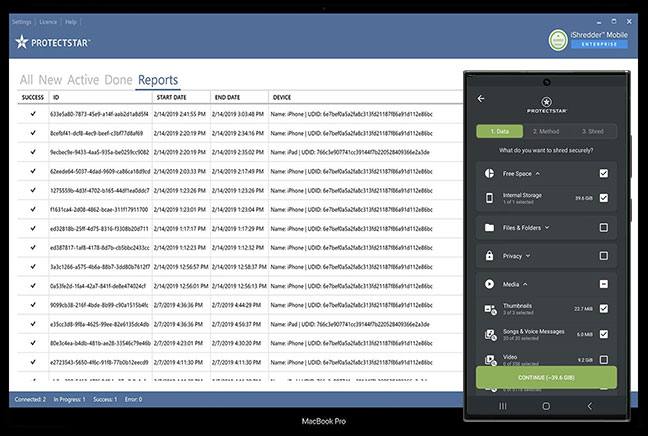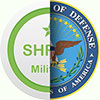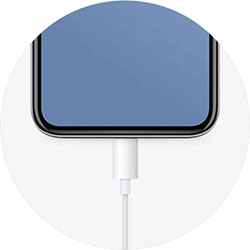iShredder™ iOS® Business Edition
Top reasons to
Choose iShredder
Irreversible Deletion
Prevent sensitive data from being recovered later. iShredder™ removes files so thoroughly that even professional recovery tools fail.
Certified Deletion Algorithms
Whether it’s DoD 5220.22-M, NIST SP 800-88, BSI TL-03423, or other recognized standards — iShredder™ uses algorithms trusted by the military and government agencies alike.
Three Steps to Success
Simply select the data you want to erase, choose the deletion algorithm, and confirm with one click. Your data is securely gone.
Cleaning Temporary Files
iShredder™ also hunts down hidden caches, logs, and other leftovers. This frees up storage space and prevents unwanted data traces.
Perfect for Selling Your Device
No one should gain access to your private photos, passwords, or other information. With iShredder™, you can safely pass on your smartphone, tablet, or PC.
Deletion Reports & Documentation
For extra assurance, iShredder™ generates a detailed report for each deletion action — ideal for businesses that need GDPR-compliant records.
What is iShredder™
iShredder™ is the industry’s leading data erasure software for iOS, Android, Windows, macOS, and Windows Server. Since 2010, it has received numerous awards and is trusted by more than 5,000,000 users in over 100 countries. Leveraging advanced and patented data shredding algorithms, iShredder™ surpasses international security standards — so robust that even government agencies and defense ministries depend on it for complete and irreversible data removal.

Securely Erase Multiple iOS Devices
iShredder™ iOS Enterprise or iShredder™ iOS Business enable you to wipe multiple iPhones and iPads simultaneously — whether you have two or a hundred devices. Once the erasure is complete, iShredder™ automatically resets each device and installs the latest iOS operating system, returning it to “like-new” condition. A detailed, DSGVO-compliant wipe report is then generated and digitally signed, verifying that every device has been securely wiped.


Exceeds International Standards
All iShredder™ Business products for iOS and Android exceed stringent government and military security standards. Each erasure method is meticulously analyzed by independent authorities, ensuring absolute and permanent data destruction. Every successful wipe is documented in a comprehensive report, providing proof of compliance and peace of mind.
-
![Connect your device]()
Connect your device
-
-
![Choose a method]()
Choose a method
-
-
![Begin to shred]()
Begin to shred
Complete Data Erasure on Android
Manually deleting files, photos, messages, and call logs does not fully remove them. Until those memory sectors are overwritten, the data can still be recovered. iShredder™ Android Business Edition ensures this data is permanently erased using secure, patented algorithms. In just three steps, the software wipes your device beyond forensic recovery and provides a verifiable erasure report — ideal for companies that need documented proof of data destruction.
-
![Select the data]()
1. Select the data
-
-
![Choose the method]()
2. Choose the method
-
-
![Begin to erase]()
3. Begin to erase

Secure Android® Device Erasure?
Today, with little effort, it's easy to recover allegedly deleted data such as notes, passwords, address books, WhatsApp, videos, calendars, and much more from your Android® device's memory.
If you or your company want to sell or pass on an Android® smartphone or tablet, the data stored on it must be securely deleted and not recoverable by third parties. You will need a deletion log as proof.
Over 20 Certified Erasure Algorithms









iShredder™ offers over 20 globally recognized and patented erasure algorithms, including: DoD 5220.22-M E / ECE, BSI TL-03423, BSI-2011-VS, NIST SP 800-88 (including Purge method), NATO Standard, HMG InfoSec No.5, and many more.
These methods have been vetted by government agencies and independent security organizations worldwide, ensuring they meet or exceed rigorous data destruction standards.
Specifically developed by Protectstar™ Inc. in 2007 it runs through fifty erasure routines.
Data will be overwritten for two times with a random value, afterwards with their complements. It includes the DoD 5220.22-M (E) standard and Peter Gutmann method and random algorithms.
The algorithm from Peter Gutmann was found in 1996 and makes 35 overwrite passes in total.
This algorithm is one of the state-of-the-art methods for data destruction.
In March 2010 the German Federal office for IT Security (BSI) published a new technical BSI Guideline for "Requirements to overwrite memory media".
The method is similar to VSITR standard for magnetic storage media.
In total the new algorithm has 8 cycles, which has to be worked through in chronological order. Includes one cycle of verification.
The NATO method is the deletion standard of North Atlantic Treaty Organization (NATO).
It will overwrite the target data area 7 times.
The first six overwrites are with the fixed values (0x00) and (0xff), alternating between passes.
The 7th overwrite is with a random value i.e. 0x00,0xFF,0x00,0xFF,0x00,0xFF and 7th pass with a random value.
The method for high security is based on the January 1995 'National Industrial Security Program Operating Manual'by the Department of Defense (DoD).
In this seven cycle variation (DoD 5220.22-M ECE), data is first overwritten three times with DoD 5220.22-M (E) Standards, then with a specific random value, and finally once again with DoD 5220.22-M (E).
The Royal Canadian Mounted Police Standard RCMP TSSIT OPS-II overwrites data securely with alternating sequences with a total of seven cycles.
The German Federal office for IT Security (BSI) describes in the technical BSI guideline for 'Requirements to overwrite memory media' from July 2010 the modern method BSI-2011.
This clause includes 5 steps, which is implemented in sequential order.
ASDA enables highly effective, verifiable data erasure with minimal resource consumption. The four passes are designed for efficiency and transparency: read‑after‑write verification and deletion logs document every step. AES‑256 and cryptographically strong random numbers make forensic reconstruction significantly harder. The implementation integrates seamlessly into existing processes.
This method is specially developed for SSD (Solid State Drive) and flash memory, based on the U.S.
Department of Defense's standard DoD 5220.22-M E. It will overwrite data four times.
The Canadian CSEC ITSG-06 sanitization method has three cycles and was published in 2006 by Communication Security Establishment Canada (CSEC).
The HMG Infosec Standard No 5 - enhanced level is approved to wipe UK Government Top Secret data and has also been approved by NATO.
The algorithm is a three pass overwriting algorithm: first pass - with zeros (0), second and third passes with its complement and random values(with last pass verification).
The AFSSI-5020 sanitization method was originally defined in the Air Force System Security Instruction 5020 by the United States Air Force (USAF) in 1996 and may still be today.
This is the US Navy standard NAVSO P-5239-26 for MFM encoded drives.
This deletion method first writes the fixed value (0xffffffff) to the target data area, then the fixed value (0xbfffffff) and then random values.
Finally, the target data area is read to verify the overwrites.
This is the US Navy standard NAVSO P-5239-26 for RLL encoded drives.
This deletion method first writes the fixed value (0xffffffff) to the target data area, then the fixed value (0x27ffffff) and then random values.
Finally, the target data area is read to verify the overwrites.
AR380-19 is the data shredding algorithm specified and published by the U.S. Army.
The algorithm is a three pass overwriting algorithm: first pass - with random bytes, second and third passes with certain bytes and with its complement (with last pass verification).
The method for low security but for high execution speed is based on the January 1995 'National Industry Security Program Operating Manual' from the DoD (US DoD 5220.22-M).
The variation (DoD 5220.22-M E) offers 3 cycles in which the data are overwritten with first a set value, then its complement , and then a random value.
The American NCSC-TG-025 standard of the National Computer Security Center (NCSC) securely overwrites existing information on a data medium three times.
The in 2006 released standard is the Special Publication 800-88 from NIST, which is the go-to data erasure standard for organizations in the United States. Its principles can apply to magnetic, flash-based, and other storage technologies, from USB drives to servers.
The Russian data deletion standard GOST R 50739-95 for secure data erasure overwrites the target data area two times. In the first pass with a zero, and in the second pass with random characters.
ISM 6.2.92 is the Australian government's data sanitization standard.
The method was originally defined in the Information Security Manual (ISM) issued by the Australian Department of Defense: Intelligence & Security.
The ISM 6.2.92 sanitization cannot be used to sanitize classified information.
This method is specially developed for SSD (Solid State Drive) and flash memory.
It offers one cycle which data are overwritten by the pattern "0xFF".
This method for lowest security but for very high execution on speed. It offers only one cycle which data are overwritten with random values.
In December 2014, the guidelines were revised, making the current version “NIST Special Publication 800-88 Rev. 1”.
See here the description of the method you have selected.
Overwriting
Free Space
When you delete a file, most operating systems simply mark its storage space as “free” without truly erasing the data. With iShredder™’s award-winning Freespace Erase feature, every unallocated memory block is securely overwritten. This process guarantees that any previously deleted data remains permanently irrecoverable.

Certified Algorithms & Detailed Reports
With over 20 recognized erasure algorithms, iShredder™ exceeds international government and military security standards for secure data erasure. Each method — such as DoD 5220.22-M E/ECE, NIST SP 800-88, and BSI-2011-VS — has been vetted by government agencies or independent organizations, ensuring permanent data destruction. Upon completion of each wipe, iShredder™ automatically generates a detailed erasure report to confirm compliance with data protection regulations.

GDPR/DSGVO-Compliant Data Erasure
The European General Data Protection Regulation (EU-DSGVO) has made secure, documented data erasure a legal requirement for all organizations. Should sensitive information be mishandled, businesses risk fines, legal consequences, and reputational damage. iShredder™ fully complies with DSGVO (GDPR) guidelines, including the “Right to Erasure” (Art. 17, GDPR-info.eu), by providing digitally signed reports that confirm complete data destruction.

System requirements
- iOS Business
- iOS Enterprise
- Android Business
-
Supported OS for software
-
macOS 11.0 or higher
-
-
Supported iOS Devices
-
All iPhone models
-
All iPad models (from iPad, iPad mini, iPad Air and iPad Pro)
-
All iPod touch models
-
All iOS versions and iPadOS
-
-
Minimal Hardware Requirements
-
Minimal system requirements of the operation system
-
30 MB free hard drive space
-
Internet connection for updates and activation
-
-
Languages
-
English, German
-
-
-
Supported OS for software
-
Windows 10 or higher
-
-
Supported iOS Devices
-
All iPhone models
-
All iPad models (from iPad, iPad mini, iPad Air and iPad Pro)
-
All iPod touch models
-
All iOS versions and iPadOS
-
-
Minimal Hardware Requirements
-
Minimal system requirements of the operation system
-
30 MB free hard drive space
-
Internet connection for updates and activation
-
-
Languages
-
English, German
-
-
-
Supported OS for software
-
Android 5.0 or higher
-
-
Supported Android Devices
-
All Android Smartphones & Tablets
-
-
Minimal Hardware Requirements
-
Minimal system requirements of the operation system
-
30 MB free hard drive space
-
Internet connection for updates and activation
-
-
Languages
-
English, German, Russian, French, Spanish, Arabic, Serbian, Slovak, Persian, Filipino, Hungarian, Indonesian, Italian, Japanese, Korean, Portuguese, Swedish, Chinese, Urdu
-
-
Features and pricing
-
iShredder iOS Enterprise
Purchase Erasure Credits
-
iShredder iOS Business
Unlimited connected devices
-
iShredder Android Business
Purchase Volume License














